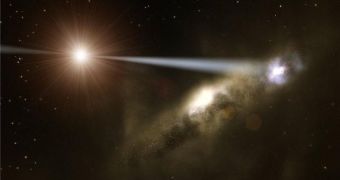Experts have known for a long time that at the heart of very large galaxies lie supermassive black holes, with a mass several millions of times that of our own Sun. Since they learned this, astronomers have been trying to establish causal relationships between the two, as in which of the structures triggers the formation of the other one. The answer that was recently discovered appears to be that the black holes are the main “engines” behind galactic formations, AlphaGalileo reports.
“The ‘chicken and egg’ question of whether a galaxy or its black hole comes first is one of the most debated subjects in astrophysics today. Our study suggests that supermassive black holes can trigger the formation of stars, thus ‘building’ their own host galaxies. This link could also explain why galaxies hosting larger black holes have more stars,” expert David Elbaz says. The scientist, based at the European Southern Observatory (ESO), is the lead author of a new paper detailing the finds.
The nearby quasar known under the catchy name of HE0450-2958 has been the main target of the new observations, which were conducted using the Observatory's Very Large Telescope (VLT). The object features no host galaxy yet, which makes it of great interest to astronomers. The mid-infrared instrument on the VLT that was used for the research was supposed to clear the object's mystery by revealing an alleged galaxy inside the massive cloud of dust surrounding the quasar.
“Observing at these wavelengths would allow us to trace dust that might hide the host galaxy. However, we did not find any. Instead we discovered that an apparently unrelated galaxy in the quasar’s immediate neighborhood is producing stars at a frantic rate,” Knud Jahnke, the expert in charge of the new VLT observations, reveals. The team noticed that the nearby galaxy was producing stars at a rate of about 350 Suns per year, which is a lot, and fast. According to experts, this is 100 times the average rate of stellar formation in the Universe.
The study also seems to show something entirely new. The quasar itself appears to be delivering a large jet of highly energetic particles into the heart of the nearby galaxy, as well as a a large stream of fast-moving gas. These additions to the galactic core may be the main engines behind the formation's unusual traits, the ESO team hypothesizes. In essence, the researchers say, it may be that galaxies first formed from large clouds of dust and gas, zapped with jets generated from quasars and black holes.
“The two objects are bound to merge in the future: the quasar is moving at a speed of only a few tens of thousands of kilometers per hour with respect to the companion galaxy and their separation is only about 22 000 light-years. Although the quasar is still ‘naked,’ it will eventually be ‘dressed’ when it merges with its star-rich companion. It will then finally reside inside a host galaxy like all other quasars,” Elbaz explains.

 14 DAY TRIAL //
14 DAY TRIAL //